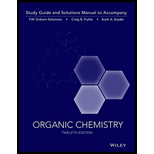
Give structures (including stereochemistry where appropriate) for compounds A–G:
(a)
(Hint: The
(b)
(c)
(d)
Want to see the full answer?
Check out a sample textbook solution
Chapter 15 Solutions
Organic Chemistry, 12e Study Guide/Student Solutions Manual
Additional Science Textbook Solutions
Fundamentals of Heat and Mass Transfer
Introductory Chemistry (5th Edition) (Standalone Book)
Living by Chemistry
Organic Chemistry (8th Edition)
Chemistry: The Central Science (13th Edition)
Chemistry: A Molecular Approach (4th Edition)
- Compound H (C8H6O3) gives a precipitate when treated with hydroxylamine in aqueous ethanol and a silver mirror when treated with Tollens solution. Following is its 1H-NMR spectrum. Deduce the structure of compound H.arrow_forwardCompound I (C11H14O2) is insoluble in water, aqueous acid, and aqueous NaHCO3, but dissolves readily in 10% Na2CO3 and 10% NaOH. When these alkaline solutions are acidified with 10% HCl, compound I is recovered unchanged. Given this information and its 1H-NMR spectrum, deduce the structure of compound I.arrow_forwardNitriles, R–=C≡N, undergo a hydrolysis reaction when heated with aqueous acid. What is the structure of the compound produced by hydrolysis of propanenitrile, CH3CH2C≡N, if it has IR absorptions from 2500–3100 cm-1 and at 1710 cm-1, and has M+=74?arrow_forward
- Propose a structural formula for the analgesic phenacetin, molecular formula C10H13NO2, based on its 1H-NMR spectrum.arrow_forwardWhen compound A (C5H12O) is treated with HBr, it forms compound B (C5H11Br). The 1H NMR spectrum of compound A has a 1H singlet, a 3H doublet, a 6H doublet, and two 1H multiplets. The 1H NMR spectrum of compound B has a 6H singlet, a 3H triplet, and a 2H quartet. Identify compounds A and B.arrow_forwardIn an aqueous solution containing sodium bicarbonate, aniline reacts quickly withbromine to give 2,4,6-tribromoaniline. Nitration of aniline requires very strong conditions,however, and the yields (mostly m-nitroaniline) are poor.(a) What conditions are used for nitration, and what form of aniline is present under theseconditions?arrow_forward
- Provide reagentsarrow_forward1. At what position and on what ring would you expect the following substances to undergo electrophilic substitution? (b) CH3 Br lel CH3 2. Rank the compounds in each group according to their reactivity toward electrophilic substitution. (a) Chlorobenzene, o-dichlorobenzene, benzene (b) p-Bromonitrobenzene, nitrobenzene, phenol (c) Fluorobenzene, benzaldehyde, 0-xylene (d) Benzonitrile, p-methylbenzonitrile, p-methoxybenzonitrilearrow_forward1 (a) In the following reactions, CI (1) LIAIH, A (2) H20 MCPBA (i) Draw the structure of compounds A and B. (ii) For each reaction, explain the type of reaction involved. (iii) Explain the successful transformation of compound A using mass spectra. (b) Complete the following reactions by filling in missing reactants or product. (i) (1) O3 (2) CH;SCH3 (ii) он (CH3)3(COOH) D Ti(OCH(CH3)2l4 (-)-DETarrow_forward
- Compound A undergoes an acid-catalyzed hydrolysis. One of the products (B) that is isolated gives the following 1H NMR spectrum. Identify the compounds A and Carrow_forward(a) (b) HO N N-H Catalytic H+ (-H₂O) ? (c) NH2 HO N (d)arrow_forwardHeating compound X with aqueous formaldehyde forms Y (C17H23NO), which has been converted to a mixture of lupinine and epilupinine, alkaloids isolated from lupin, a perennial ornamental plant commonly seen on the roadside in parts of Alaska (Section 25.10). Identify Y and explain how it is formed.arrow_forward

 Organic ChemistryChemistryISBN:9781305580350Author:William H. Brown, Brent L. Iverson, Eric Anslyn, Christopher S. FootePublisher:Cengage Learning
Organic ChemistryChemistryISBN:9781305580350Author:William H. Brown, Brent L. Iverson, Eric Anslyn, Christopher S. FootePublisher:Cengage Learning

